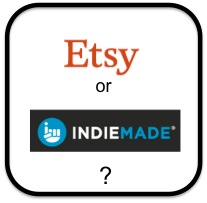
I decided to add my two cents to the comparison of selling handmade jewelry on Etsy versus Indie Made. I’ve had a shop on Etsy since December 2008. I set up a shop on Indie Made in July 2014. I’ve had 74 sales on Etsy and none on Indie Made. You may be thinking those stats would stack the deck in favor of Etsy for this review. Not so fast.
I’ll start with the features I like better on Indie Made, compared to Etsy. I won’t comment on all their features, just the ones I’ve tried. For context, I’m using the “Pro” plan on Indie Made. There are four plan levels that range in price and features: basic, standard, pro, and plus. They have a nice little table that compares prices and features among plans.
1. Branding and appearance
When you visit my IndieMade site, all you’ll see is content from me. The banner is mine and I can make it any size or shape I want. The photos are mine, and I can change their size. The words are mine. Even the color of the words and the font style and sizes are my choice. I am in total control of how I brand my pages. With the plan I have, I can have up to 10 pages. I choose where to put the navigation for those pages and what to label them as well as what to put on them. I can change their labels, their content, and their location when I want.
Okay, yes, the page template is theirs. But since I can choose from dozens of templates, and further customize them, I’m sticking with: it’s mine, all mine. And if you know a little html and css, the sky’s the limit for customizing your page. Sure, there’s a teeny tiny little “powered by IndieMade” link down in the bottom right corner of my pages. I could get rid of that by upgrading to the “plus” plan. Truthfully though, I don’t mind that tiny bit of advertising for them. It’s inconspicuous and they deserve it.
In comparison, when you visit my Etsy shop, you will see Etsy branding in bold orange letters right at the top of any page. If you click on it, you are zipped right out of my shop and into the main Etsy page quicker than you can say “competition.” The banner is still mine, but constrained in size by the Etsy template. Except when Etsy is running one of their tests where they take away shop banners all together. (Don’t even get me started on Etsy’s testing.)
The item photos and descriptions are still mine. The format and overall appearance is all Etsy. And subject to change without notice. I have no control over how, or whether, my Etsy site is branded to represent me, versus Etsy. It’s like having a shop in a mall where every store front has to look identical and the name of the mall is larger than the name of the shop.
Some people might say “Well, Etsy is free, so users can’t really complain if they choose to make changes to their site.” Here’s the thing. It isn’t. Free, that is. True, there’s no recurring flat monthly fee as there is with Indie Made. But there is a fee to add an item to my shop. And that item will expire and disappear from my shop if I don’t pay the same fee every three months. Over and over.
If my jewelry was selling before it expired, then that listing fee (currently $0.20 USD) is no big. But since I haven’t hit the big time with my sales yet, that recurring listing fee can take a big bite out of my small profit margin. At some point, I could have spent the equivalent of the price of the item in listing fees if I’m not paying attention. Etsy also takes a percentage of the price of every item sold.
So, no, Etsy is not free. (and I don’t think they claim to be) There are monthly fees. They’re just highly variable and unpredictable. Just like the appearance of my shop. Do I think the fact that I pay fees to Etsy means I should have a say in how they decide to make my shop look and function? I would hope they consider input from shop owners, but ultimately, it’s their company to run as they choose. And I can stay or go as I choose, just like any renter.
2. Visibility
Within the first 24 hours of setting up my Indie Made shop my item listings were showing up in Google searches. I can add meta tags to my Indie Made listings and photos to further enhance their visibility in searches. I can even add alt tags to my photos. But I don’t have to. Indie Made has some kind of magic programming that optimizes SEO (search engine optimization) just based on what I typed in my item titles and descriptions.
Also, there’s a search function on my Indie Made site. It comes standard and I can decide where to put it for navigation. If you type anything in that box, it will only return results from my Indie Made shop. No where else.
Etsy has some kind of magic too. (Note: it’s technically magic if I don’t understand it.) But I cannot add meta tags for items, or alt tags to photos. And when you search on Etsy, if you aren’t paying attention to which box you used – the great big one featured prominently at the top of every item page versus the smaller one that’s only on my main page and is a few inches below my banner (if I have one, which comes and goes at Etsy’s whim) – what you’ll get are results from all of the shops on Etsy. Etsy is escorting you out of my shop and into their mall. It’s all the same to them. They get their fees regardless of which shop you buy your earrings from.

See the search bar at the top of the page next to the Etsy logo hyperlink? Takes you out of my shop and into Etsy’s marketplace.
Etsy lets me add “tags” to my item listings. These apparently don’t affect SEO, and are only used for searches within Etsy. And guess what? If you click on one of those tags at the bottom of my listing, Etsy will take you by the hand and whisk you off to their marketplace to show you all the the [same or related tag] items that can be found on the entire Etsy site. Not my shop. Everyone’s shops. That might be a great feature for a comparison shopper. But it’s not so wonderful for the small independent artists on Etsy.
3. Hyperlinks
I can add hyperlinks (those magic carpet-like words and buttons and icons you click that take you to other places on the internet) anywhere I want on my Indie Made pages. (Note: the one exception is the Contact page. That puppy is the one and only hardwired content feature I’ve encountered on IndieMade. I can choose where to put it, but not what’s in it.)
I can point these hyperlinks to other pages of my Indie Made site, or other listings in my Indie Made store. To my blog. My Facebook page. My shop on Etsy. The Self Representing Artists in Jewelry Design page. (see what I did there? That’s a hyperlink.) I can choose whether clicking on the link takes you away from the page you were on, opens in another tab, another window, etc. Not only is that a nifty feature, it enhances the SEO for my pages and site overall.
Etsy does not like you to leave Etsy. I can have hyperlinks within my item descriptions only if they link back to somewhere else on Etsy. I can’t, for example, have a hyperlink to my blog from within my Etsy shop announcement section. I can type the url for my blog there, but if you want to visit that page you have to copy and paste the url into a window in your browser. Clicking on it won’t do a thing. I do add hyperlinks in my item listings to help shoppers find their way back to my sections. I call these “faux breadcrumbs” and use them because Etsy does not provide actual breadcrumbs.
There’s only one place on Etsy I can hyperlink to sites off Etsy, and that’s on my shop’s About page. Where I can have a maximum of three links. That policy likely helps Etsy’s SEO, but doesn’t do nearly as much for my shop. And getting to my About page is not necessarily intuitive, especially if it isn’t where it was the last time you were on Etsy. So, the odds of people finding those links to my blog, my Facebook page, or my website are not in my favor.
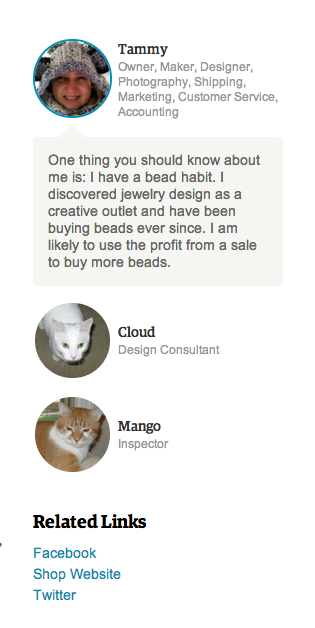
This is from the right column on my Etsy About page. The only place non-Etsy hyperlinks are allowed.
4. Social media buttons
There are social media buttons at the top of my Indie Made pages. They connect you to me on Facebook, Google+, Pinterest, and Twitter. I can choose which social media buttons to have, and where on my page to put them. I can have as many or as few as I want. There are also social media sharing buttons within each item listing. They let you tweet, like, stumbleupon, pin, plus 1, etc. that item listing. Again, I can choose which ones, or none.
This makes it easy for visitors to my Indie Made site to connect with me, and to share with their friends when they see something they like on my pages. I can also verify my Indie Made site on places like Pinterest. That gives people extra confidence that I am in fact the owner of the page the hyperlink points to. So they can be less worried about being redirected some place shady.
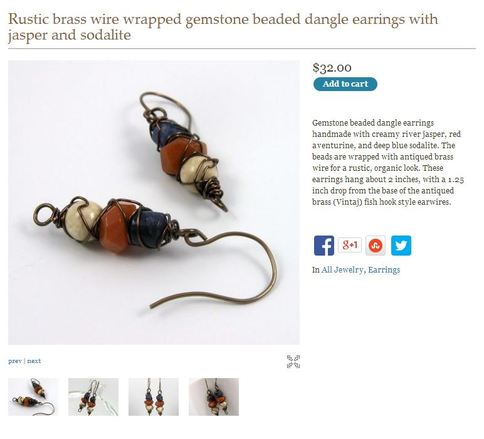
See the social media sharing buttons under the item description from my Indie Made site? (Also note the built in hyperlinks back to relevant sections in my store.)
Etsy has some built in social media buttons. I can’t choose which ones or where they go. Somewhere on my main shop page, or maybe my About page, or elsewhere depending on what test Etsy is running, I can connect my shop to my Facebook page and Twitter. On an item listing page there are automatic buttons to tweet, pin, and like. I don’t have any control over those. They are there whether I want them to be or not. And they could all be gone tomorrow. Further, you cannot verify your Etsy shop on Pinterest or Google or anywhere else. Because Etsy owns it, not you. You’re just renting a storefront in their mall, remember?
5. Store Sections
In my Indie Made store I can have as many store section as I want, and I can label them whatever I choose. For now, I choose to label them “necklaces,” “earrings,” “bracelets,” and “men’s accessories.” But if wanted, I could have sections labeled “turquoise necklaces,” “statement necklaces,” “polymer clay necklaces,” “charm bracelets,” “cuff bracelets” … You get the picture.
I can put the same item in more than one section of my shop. For example, the same turquoise beaded southwestern statement necklace could show up in “Turquoise necklaces,” “beaded necklaces,” “statement necklaces,” and “Southwest Collection” sections. That’s that many more chances my item will get seen in searches.
I can also write a description for each section, using SEO-friendly terms that help both the page and each item get higher search visibility. I can put links in the description too. And, I can decide where those section navigation links appear on my page.
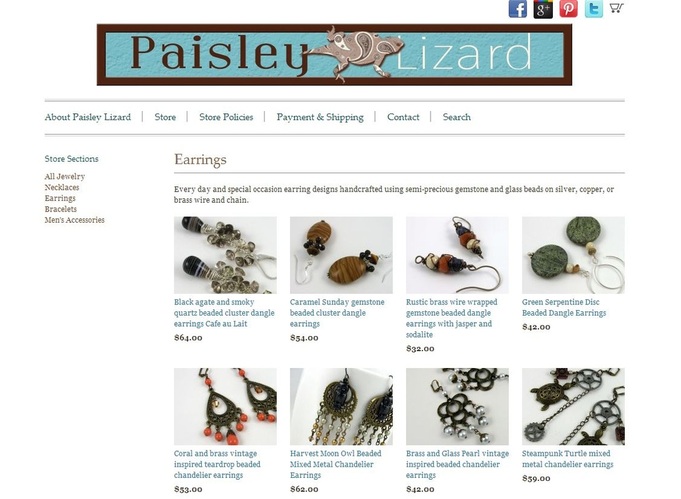
Notice the descriptive text under the large Earrings shop section heading. I decide what goes there. Or I can leave it blank.
Etsy has shop sections too: a maximum of 10 per shop. I can label them whatever I choose, as long as that label fits the Etsy template’s character limit. I can only choose one section per item. No section descriptions or hyperlinks allowed either.
So far, it probably sounds like Indie Made is the winner and you may be wondering why I bother to keep a shop on Etsy given my obvious annoyance at how little control I have over my shop’s appearance. Here’s the deal: there may come a time when I do close my shop on Etsy. Either because they implement a change I simply cannot get behind, or because it just becomes too time consuming to keep up with all their changes.
For now, I keep my Etsy shop open for the same reason others who have compared it to Indie Made and other online markets do: traffic. It’s a large well-known marketplace and there’s a chance someone will wander into my shop and buy something. Granted, it isn’t the handmade haven it used to be. And there are plenty of people who left on principal when Etsy decided to officially allow mass-produced items in direct competition with small independent artisans.
That change doesn’t thrill me either. But I’ve never assumed Etsy was working for me and I have to believe there are still discerning consumers out there who not only can spot the difference, but choose to buy authentic handmade. It’s my job to find those people. Or rather, to help them find me on the internet. (Hence my obsession with learning all things SEO and social media.)
Also, it’s super duper easy to have a shop in both places thanks to Indie Made’s feature that lets you connect the two shops. I can upload my entire Etsy inventory (photos, titles, descriptions, prices, etc.) to Indie Made with a few clicks. I can also create a new listing on Indie Made and push it to my Etsy shop. Indie Made keeps track of my inventory and when something sells from either site, it becomes unavailable on the other. I have it set that way because I sell one-of-a-kind pieces. Indie Made can also keep track if you stock multiples of an item.
Now, as I said in the beginning, I haven’t tried all the features Indie Made has to offer. So, there are probably even more reasons a control freak like me would prefer Indie Made over Etsy. But to be fair to Etsy, there are some things on my Indie Made features wish list that right now only Etsy has. And here they are.
1. Items per page.
As of this writing, the maximum number of items visible per page within a shop section on Indie Made is 12. That keeps everything “above the fold” on a computer monitor, and perhaps some tablets. But it means shoppers can’t simply scroll down to see the full selection of all my shiny jewelry designs. They have to click the “next” page button. Apparently, we humans are increasingly lazy and given the choice between only seeing 12 items or having to click a button a few times to see all 200, we’ll stop at 12. Give us the option to scroll however, and we’ll keep looking at a page until our retinas burn up. Or we get distracted by a squirrel, text message, piece of lint.
Meanwhile over on Etsy – and keep in mind things change in a heartbeat there – you can see 24 items per page. That’s twice as many shiny pieces of my handmade jewelry visible to you for the same amount of effort on your part. Which kind of doubles my chances you’ll find something you want to buy.
Control Freak Wish List Item #1 is for Indie Made to give me control over how many items are visible per page.
2. Batch or Bulk Editing
This is a feature on Etsy that they added some time after I opened my shop. I don’t recall when. I just remember people in the Etsy forums begging for the ability to make global changes in their shop. Like being able to apply a new listing variation or shipping option to every item in my shop, or just the ones I select. That’s a big time saver when you have hundreds of items. Heck, it’s a time saver if you only have a handful. And when you are an independent artisan, your time is literally your money. Every minute I spend editing my listings is time not spent making new jewelry, or trying to drive traffic to my site via social media interactions. Granted, this Etsy feature is not nearly as powerful as I would prefer. But every little time saver helps. And it’s still impressive magic as far as my computer programming knowledge goes.
Control Freak Wish List Item #2 is for Indie Made to offer a batch edit tool at least as powerful as the one on Etsy.
3. Drag and drop itemizer
On Etsy, sometimes, depending on what test version they’re running, I can click the “rearrange your shop” button and drag and drop my item listings to rearrange them within a page, or move them to another page. Again, this is something they added in the last 5 or 6 years. It’s nifty. And essential. Because Etsy’s default is to show items in the order they were most recently listed. Or relisted (remember, they have to re-up every 3 months).
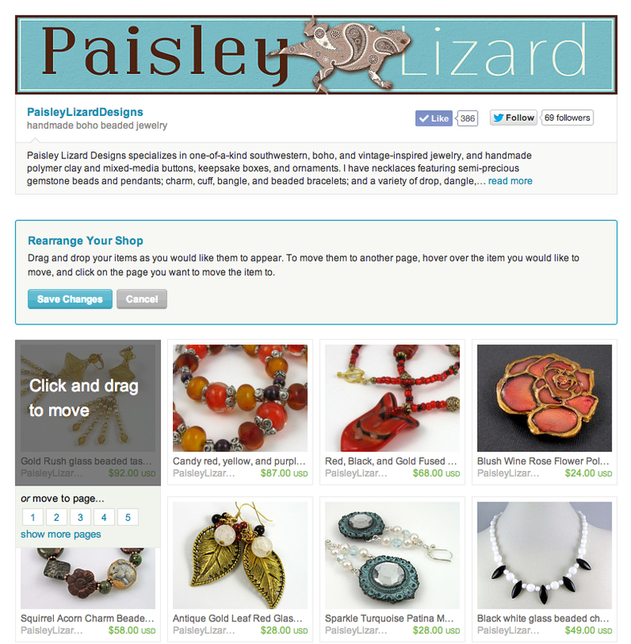
Notice the grayed box with “click and drag to move” text overlaying the first item on this page. This is the Etsy itemizer feature.
I like to arrange my items by color or style or theme. Especially the first 24, because that’s a shopper’s first impression of my shop. I also want to show a variety of what I offer. If I were limited to the listing order, your first look at my store might show 22 pairs of earrings, a bracelet, and a polymer clay ornament.
Indie Made has a drag and drop feature, but it’s limited to moving items up and down from within the long dashboard list of everything in your store. That’s tedious and time consuming. And I find myself continuously switching back and forth between the store view and the item list to see if I like the look of the 12 items that are grouped closest together. However, I will give a point to Indie Made here because things stay exactly where I put them. Until I decide to move them.
Control Freak Wish List Item #3 is for Indie Made to offer a drag and drop itemizer tool that lets me move items around in my shop or section view.
There’s one other little thing I’d like to be able to do on Indie Made. It’s not something I can do on Etsy, and it is a thing I can work around on Indie Made by adding another page. So, it’s barely worth mentioning. But as long as I’m being greedy and wishing for more when Indie Made already offers so much: I’d love to be able to edit the content of that Contact page. I’d like to be able to add my email address and maybe even a phone number. In case people want to contact me directly rather than via a web form that requires CAPTCHA.
In summary, Indie Made is made for control freaks like me. I decide [almost] everything. And I am in complete control over the most important features and functions including overall appearance and whether or how I redirect customers away from my store. Etsy still has value. But it is also a constant source of frustration for someone like me who wants to be in control.
Thanks for reading. I hope you’ve found this information useful in your considerations about setting up shop on Indie Made, Etsy, or both. If you have feedback about your experiences with either platform, please share in the comments.
Disclaimer: I am not affiliated with Indie Made or Etsy other than having stores on both sites. No one paid for comments and these are purely my own opinions and observations.
Author’s note (9 November 2014): If you commented on this post during October or November, your comments were lost when I transitioned my website to a new platform. I truly appreciate everyone who took the time to read this post and leave comments. My sincere apologies to those whose comments are not represented.


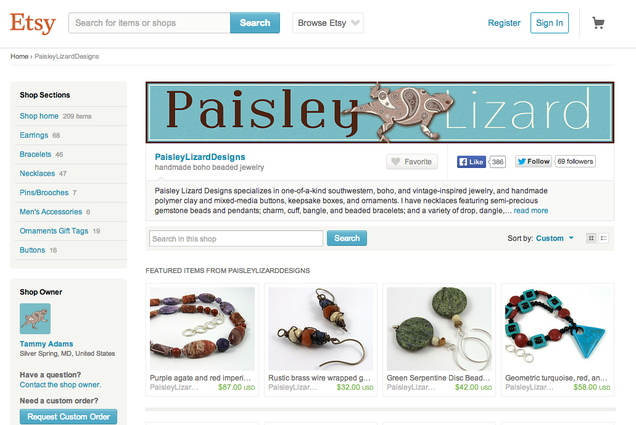
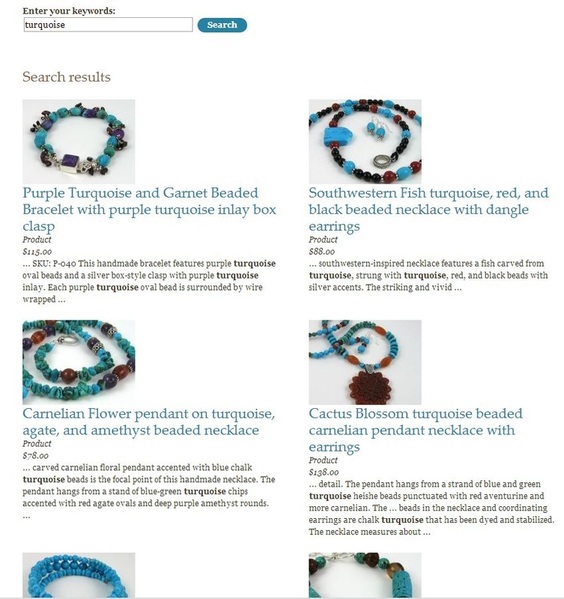

Very helpful contrast and compare post!
Thanks, Bleu. Glad you found it helpful.
Thanks for taking the time to write everything I was thinking!
You’re welcome, Charlene. I’m sure I missed a few things, but I can always write another post. 😉
Thanks for all this information, Tammy! I may have to look further into Indie Made.
You’re welcome, Gina. Their site has lots of info for getting started too.
Brilliant write-up! Thank you for doing this!
Thank you, Karen. I try to do a little “public service” post every now and again. 😉
Thanks for posting this thorough review – I really appreciate the “fair and balanced” approach you’ve taken. I’ll be referring to this as I make my own online selling choices.
You are most welcome, Pamela. Maybe you’ll have some insights re: Artfire to add to the comparison. I had a shop there for years but didn’t put enough effort into it.
Excellent Blog, thank you for all your research and sharing. I learned a lot.
Thanks, Allison. I’m still learning myself. Stay tuned for updates as I try the other features. 🙂
Thanks so much for this review! I had been quite curious since you first mentioned it on facebook, and am now even more interested in checking out Indie Made… especially with their link-up feature to the etsy shop, nice that if an item sells on either site it will become disabled at the other!
You’re welcome, Beth. I had a test of that link feature when someone bought earrings from my Etsy shop. It didn’t work, because I changed the item title on Etsy and didn’t re-link to IM. Lesson learned. 🙂
Very interesting points, Tammy (you had me at “control freak”). The lack of which has made it impossible for me to consider online selling. At least for now. But this one definitely sounds promising
Thanks, Monique. I continue to have a great experience with them. They have friendly and helpful support staff and seem dedicated to helping artisans.
What a great article. I am always considering a site for when Etsy decides to do something I can not support any more. I would like to have a site set up for that day. My concern is, how do I get people to my website? I get the views and sales on Etsy and I am concerned how to get people to say, Indie Made. Any insight would be appreciated it. I shared this great article on twitter and I will share it with one of my teams on Etsy. Thanks for so much great info.
Thank you, Kathy. And thanks for sharing the post. As for how to get traffic to your website, there are lots of options. Which one works best depends on who your customers are. I use a few social media outlets, like Facebook and Twitter, to spread the word. And I blog. 🙂 Oh, and I shamelessly give my business cards to everyone. Best of luck if you decide to give Indie Made a try.
Thanks, Tammy. I plan on rebranding this winter, so maybe I will give Indie Made a try at that time. 🙂
WOW, that was helpful. Thank you so much for taking the time to write this post–I’m just starting to sell through Etsy (though I’ve had the shop forever), and I just discovered Indiemade and think I might need to set up shop over there too (or instead of, maybe…not sure yet). This information is just what I needed–it confirms a lot of what I’ve been thinking, and gives me some new things to chew on. Thanks again.
Hi Amy, I am glad you found this helpful. Good luck with setting up a new shop if you decide to go that route.
Hi Tammy,
I have been thinking about the plunge to an Indiemade (or other) stand alone website this year. You have written a great post about the pros and cons, since you wrote this last August I am wondering if you have had any sales yet on the IndieMade site? I will probably keep both shops also. One other question do you use the same name for both sites? or are they different? Thanks for your response and the great article.
Linda
Hi Linda. I confess, I have not been putting much effort into promoting my IndieMade website since I set it up. It’s on my to-do list. I am using the same business name, and the IM shop is linked to my Etsy inventory. So many of my jewelry pieces appear on both sites. And when I’ve had a sale, the inventory has automatically updated on the other site, just as IM designed it.
Tammy, thank you so much for taking the time to prepare such an exceptional comparison between Etsy and IndieMade. You really addressed the differences….and pros and cons in a way that made it interesting and informative.
I have had my Indie site prior to establishing one on Etsy but am just now after several years getting more involved daily into making my Indie site much more comprehensive and complete. Your article gave me some very helpful information!
Thank you again! And your work is beautiful!
Great insights and some new info for me!! Thank you!!!
I really enjoyed reading this, I need to process all the information, so I will haunt your page a bit to take it all in! Thank you friend!